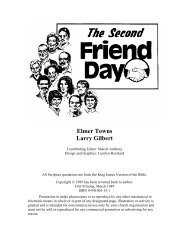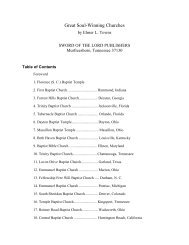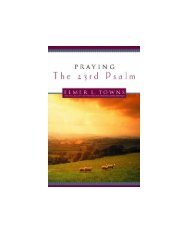PUTTING AN END TO WORSHIP WARS - Elmer Towns
PUTTING AN END TO WORSHIP WARS - Elmer Towns
PUTTING AN END TO WORSHIP WARS - Elmer Towns
- TAGS
- worship
- elmer
- towns
- elmertowns.com
You also want an ePaper? Increase the reach of your titles
YUMPU automatically turns print PDFs into web optimized ePapers that Google loves.
So the old phrase "the church of your choice" no longer means your doctrinal choice.<br />
Like buying a sweater, "the church of your choice" is a church that reflects your style of life and<br />
your way of worshiping God.<br />
While these motives are negative factors in our churches because they minimize the<br />
doctrines taught in the Words of God, there is one plus. More non-church people are coming to<br />
our worship services than in previous years. When people search out churches where they find<br />
meaning or where their life's goals are supported, consumerism has resulted in an open door for<br />
evangelism.<br />
STYLES OF <strong>WORSHIP</strong> <strong>AN</strong>D MINISTRY<br />
Historically, there have been two basic worship styles in the Protestant Church since the<br />
Reformation-"high church" and "low church." To describe them functionally we might refer to<br />
them as the liturgical worship service and the congregational style of worship.<br />
Liturgical worship usually follows a printed order of events that include the Invocation,<br />
Doxology, the Lord's Prayer, choir anthems, responsive reading of Scripture, choral response to<br />
the pastoral prayer, the Gloria Patri and the singing of "Amen" at the end of each hymn. Many<br />
believe the atmospheric worship of the Liturgical Church service expressed New Testament<br />
Christianity. Historically, there have not been many voices to challenge the credibility of this<br />
worship, but now there are some contemporary voices asking questions about its validity.<br />
The second type of worship has been an expression of the common people in church<br />
groups that did not come out of the main stream of the Reformation, that is, the Brethren of the<br />
Common Life, Anabaptists, Mennonites, Moravians, Puritans, Pilgrims and others. After the<br />
Reformation this second worship tradition would be followed by such groups as the Methodists,<br />
Congregational, Baptists, and Brethren.<br />
These groups were usually led by pastors without professional education who preached<br />
extemporaneously without a written manuscript. The preaching was emotional, persuasive and<br />
filled with illustrations and the idiomatic language of the common people. "Sweaty preaching"<br />
by "plowboy preachers" called for revival and renewal, and, in response, there were tears at the<br />
mourners bench. Singing of gospel songs expressed deep emotion. The services included<br />
testimonies, prayers from the laymen and, in some groups, shouts of "Amen" or "Hallelujah!"<br />
SIX <strong>WORSHIP</strong> PARADIGMS<br />
Defined by worship styles, six worship types or paradigms can now be identified within<br />
the Protestant Church 1 : (1) The Evangelistic Church that focuses on winning the lost; (2) The<br />
Bible Expositional Church that emphasizes teaching the Word of God; (3) The Renewal Church<br />
that focuses on excitement revival and touching God; (4) The Body-life Church focusing on<br />
fellowship (koinonia), relationships and small groups; (5) The Liturgical Church, which is still<br />
operational; and (6) The Congregational Church that expressed the people, also still operational.
















